From Our Archives
For other essays on this week's texts, see Debie Thomas, That They May Be One (2020); and Dan Clendenin, Judas and Matthias: Divine Mystery and Personal Destiny (2011); and Positively Maladjusted (2017).
For Sunday May 21, 2023
Lectionary Readings (Revised Common Lectionary, Year A)
Acts 1:6-14
Psalm 68:1-10, 32-25
1 Peter 4:12-14, 5:6-11
John 17:1-11
This Week's Essay
We're now six weeks after Easter. Next Sunday is Pentecost. Between those liturgical milestones, this week we celebrate the ascension of Jesus.
Christians confess that Jesus "came down" to earth in the incarnation. After his crucifixion and before his resurrection, according to last week's epistle from 1 Peter 3 and the Apostles' Creed, he went "down" even further to the underworld in the "harrowing of Hell." And now this week Jesus "goes up" to heaven in the ascension. Finally, after Jesus "goes up" in the ascension, next Sunday the Holy Spirit will "come down" on the believers at Pentecost.
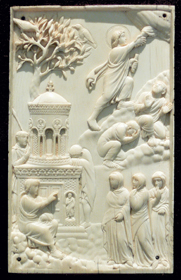 |
|
Ivory plaque, c. 400, Italy. The earliest ascension image?
|
These central affirmations of the Christian faith require us to consider our ancient religious texts in ways that honor our modern scientific cosmologies. How should we understand this language of ascent and descent? Is it metaphorical or literal, fictional or mythical? Some mix of those, or maybe something altogether different?
Matthew and Mark don't mention the ascension, except in Mark's spurious longer ending. They seem to construe the resurrection-ascension-exaltation of Jesus as a single and singular event. There are several oblique references to the ascension in John.
Luke does something different. In his gospel and in Acts, he separates the resurrection and the ascension. He writes that forty days after his resurrection, Jesus "was taken up before their very eyes, and a cloud hid him from their sight," and so he was "taken from them into heaven."
The ascension grapples with an important and perplexing ambiguity faced by the earliest believers. In what sense was Jesus now both present and absent after his death and resurrection? Luke's version of the ascension would have addressed an obvious problem that arose in those early days — continuing claims of further resurrection appearances, some of them legitimate and many of them spurious. Jesus's definitive ascension forty days after his resurrection would have put a strict limit on such claims.
In addition to Luke, there are another twenty or so references that allude to the ascension (see below for these references). By the late second century, and down to our own day in most churches around the world, every Sunday we Christians confess the ascension in the Apostles' Creed: "He ascended into heaven and is seated at the right hand of the Father."
St. Augustine (died 430) writes that the Feast of the Ascension was widely observed long before his time. Art and architecture also honored the ascension. By 384, an exact place on the Mount of Olives was venerated. In 390, a wealthy Roman woman named Poimenia financed the construction of the Chapel of the Ascension.
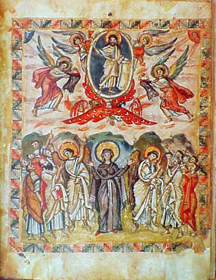 |
|
Rabbula Gospel, c. 586, Syria.
|
In our ancient texts, our creeds and confessions, and in our art and architecture — from Syrian illuminated manuscripts to Danish wall paintings, Christians have professed our belief in the ascension. But how are we to understand it?
The painting of the ascension by the Italian Andrea Mantegna that I've included with this essay, and many others like it, begs this question. It contrasts heaven "above" and earth "below," with Jesus hovering in between, surrounded by winged angels. Is that what really happened? Is that what it looked like, and what we now confess?
The controversial Jesus Seminar (1985 to 2006) with its infamous colored beads rejected the ascension as a literary fiction. Sceptics dismiss it as an embarrassing example of a pre-critical cosmology. Literalist interpretations make the sacred story sound absurd.
In his book The Big Questions in Science and Religion (2008), the Oxford theologian and ordained Anglican priest Keith Ward captures the clash of ancient and modern cosmologies that we experience with the ascension story. He writes: "We now know that, if [Jesus] began ascending two thousand years ago, he would not yet have left the Milky Way (unless he attained warp speed)."
To state the obvious, our ideas today about space and time are different from those in Luke's day. Paul described a three-tier universe in Philippians 2:10: "in heaven and on earth and under the earth." It's tempting, and condescending, to disparage this outmoded cosmology of Jesus's day by contrasting it with the updated cosmologies of contemporary physics. But this isn't as easy as it sounds, nor does it help all that much.
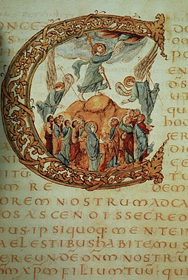 |
|
Drogo Sacramentary, c. 850.
|
Luke or Paul could not have known our modern cosmologies. They believed the best cosmology of their day — Ptolemy's geocentric view of the world, which reigned for a thousand years as the most authoritative view until Copernicus demonstrated that it was badly wrong in 1543.
But now try this thought experiment: what will today's cosmologies look like two thousand years from now? Or even a mere hundred years hence? A few years ago I read a book by the astrophysicist Mario Livio with the marvelous title Brilliant Blunders: From Darwin to Einstein — Colossal Mistakes by Great Scientists That Changed Our Understanding of Life and the Universe (2013). It's misleading to privilege any cosmology, whether ancient or modern, as a fixed and final view of the world for all time. That's just not how science works.
Today we think about space in three dimensions — latitude or length, longitude or width, and altitude or height. To these we add the fourth dimension of time. This otherwise reliable view of the world might reign for a very long time indeed, or it might turn out to be rudimentary at best if string theorists are correct.
So-called "M-Theory" proposes 11 dimensions. Stephen Hawking thought that M-theory is "the only candidate for a complete theory of the universe." But these are cosmological theories and not empirical conclusions. Other prominent physicists like Richard Feynman and Roger Penrose think that string theory fails as a "theory of everything."
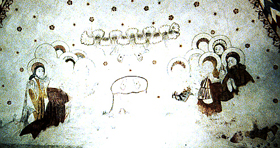 |
|
Danish church wall painting, c. 1525.
|
The ascension of Jesus was described by Luke within the context of the imperfect cosmology of his day, which has since been supplanted by our own imperfect cosmology. I don't believe that Jesus ascended "up" in the sense of Mantegna's painting or Keith Ward's clever quotation, although maybe it looked something like that. I do believe that Jesus literally exists in another dimension that is best described symbolically or metaphorically.
The philosopher Stephen Davis of Claremont University put it this way: "I do not believe that in the Ascension Jesus went up, kept going until he achieved escape velocity from the earth, and then kept moving until he got to heaven, as if heaven were located somewhere in space. The Ascension of Jesus was primarily a change of state rather than a change of location. Jesus changed in the Ascension from being present in the realm of space and time to being present in the realm of eternity, in the transcendent heavenly realm."
In the symbolic language of the early creeds, with the ascension, Jesus is now "exalted at the right hand of the Father." The ascension is thus about the exaltation of the resurrected Jesus before God, not his elevation to heaven "up there." The ascension is a theological affirmation and not a cosmological observation.
And with Pentecost next week, the Spirit of God, "who with the Father and Son is worshipped and glorified," descends like a violent wind and burning fire. Which is to say that our Christian story is deeply Trinitarian.
Our finite language about the ascension, limited by every cosmology of every age, is necessarily symbolic and metaphorical. It affirms literal realities that are infinite, and therefore ultimately indescribable.
For further reflection:
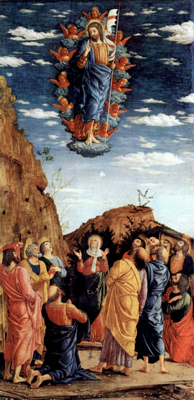 |
|
Andrea Mantegna, 1431-1506.
|
The Cambridge poet, priest, and musician Malcolm Guite on his sonnet for Ascension Day. "The mystery of this feast is the paradox whereby in one sense Christ ‘leaves’ us and is taken away into Heaven, but in another sense he is given to us and to the world in a new and more universal way. His humanity is taken into heaven so our humanity belongs there too, and is in a sense already there with him. "For you have died," says St. Paul, "and your life is hidden with Christ in God." In the ascension Christ’s glory is at once revealed and concealed, and so is ours. Anyway, the sonnet form seemed to me one way to begin to tease these things out." See Guite's book Sounding the Seasons: Seventy Sonnets for the Christian Year (2012).
We saw his light break through the cloud of glory
Whilst we were rooted still in time and place
As earth became a part of Heaven’s story
And heaven opened to his human face.
We saw him go and yet we were not parted
He took us with him to the heart of things
The heart that broke for all the broken-hearted
Is whole and Heaven-centred now, and sings,
Sings in the strength that rises out of weakness,
Sings through the clouds that veil him from our sight,
Whilst we our selves become his clouds of witness
And sing the waning darkness into light,
His light in us, and ours in him concealed,
Which all creation waits to see revealed.
For the other allusions to the ascension, see John 3:13; 6:62; 8:14, 21; 13:3, 33, 36; 14:4–5, 28; 16:5, 10, 17, 28; 20:17; Acts 2:30–33; Romans 8:34; Ephesians 1:20; 4:8–10; I Timothy 3:16; Hebrews 4:14; 1 Peter 3:22.
Weekly Prayer
Thomas Aquinas (1225–1274)
Godhead here in hiding, whom I do adore,
Masked by these bare shadows, shape and nothing more,
See, Lord, at thy service low lies here a heart
Lost, all lost in wonder at the God thou art.Seeing, touching, tasting are in thee deceived:
How says trusty hearing? that shall be believed;
What God's Son has told me, take for truth I do;
Truth himself speaks truly or there's nothing true.On the cross thy godhead made no sign to men,
Here thy very manhood steals from human ken:
Both are my confession, both are my belief,
And I pray the prayer of the dying thief.I am not like Thomas, wounds I cannot see,
But can plainly call thee Lord and God as he;
Let me to a deeper faith daily nearer move,
Daily make me harder hope and dearer love.O thou our reminder of Christ crucified,
Living Bread, the life of us for whom he died,
Lend this life to me then: feed and feast my mind,
There be thou the sweetness man was meant to find.Bring the tender tale true of the Pelican;
Bathe me, Jesu Lord, in what thy bosom ran —
Blood whereof a single drop has power to win
All the world forgiveness of its world of sin.Jesu, whom I look at shrouded here below,
I beseech thee send me what I thirst for so,
Some day to gaze on thee face to face in light
And be blest forever with thy glory's sight.Taken from Jay Hopler and Kimberly Johnson, editors, Before the Door of God; An Anthology of Devotional Poetry (New Haven: Yale University Press, 2013), 425pp.
Dan Clendenin: dan@journeywithjesus.net
Image credits: (1) Wikipedia.org; (2) Wikipedia.org; (3) Wikipedia.org; (4) Princeton.edu; and (5) Vanderbilt.edu.





